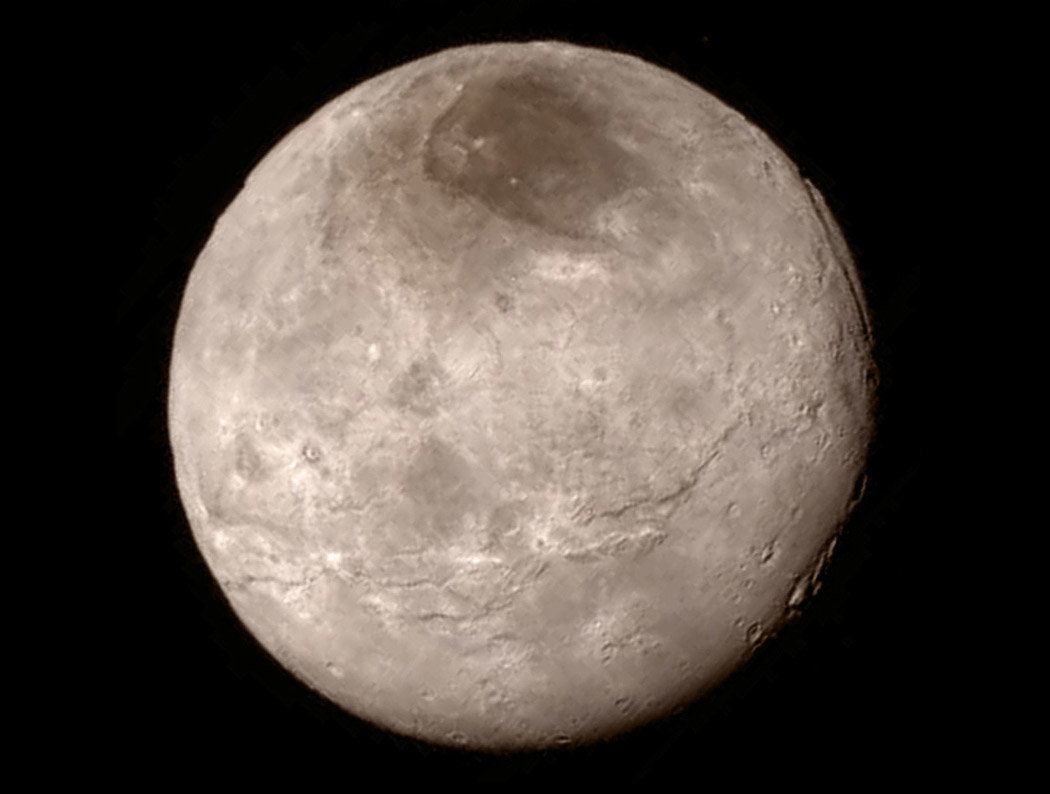A fly-by snapshot of Pluto, the dwarf planet we’ve been singing songs about since grade school, literally shed light on a mysterious interstellar mass this week. At the height of New Horizon’s mission, gritty details of geographical features were captured up close.
And, as if that weren’t enough to make a sci-fi geek giddy, NASA opened a public vote for exactly how to name Pluto’s peaks and valleys. In keeping with the tiny planet’s namesake, potential references for its features are being culled from underworld mythology. Of those suggested so far, there's Cthulhu, a character from H.P. Lovecraft, a blood-curdling octo-limbed dragon-person, and Balrog, that menacing dragon responsible for Gandalf’s near-demise in The Fellowship of the Ring. The themes for the names of features on Pluto’s many moons have mostly been decided, too -- nocturnal gods for Nix, river gods for Styx, fictional dogs for Kerberos. NASA’s OurPluto.org has more details about the voting scheme and submitted suggestions, many of which center on fictional villains and mythological, Hades-like gods.
The names we’ve given to the ridges and black spots that make up the rest of the solar system come from other far-flung fictional worlds. NASA’s official page for sources of planetary names reveals Australian legends, Norse mythology, "The Odyssey," Gulliver’s Travels, and many other classic tales as inspiration. Below, a brief guide to the galaxy’s literature-inspired features:
Mercury
Mercury’s craters are many, so the category for its names is a broad one -- authors, visual artists and musicians who’ve died more than 50 years ago, and who’ve made a major contribution to their field. This isn’t restricted to science-fiction writers. Charles Dickens, Anton Chekhov, Ruyard Kipling and William Butler Yeats all have craters to their names. The most notable science-fiction writer with a crater on Mercury named after him is Robert Louis Stevenson, the author of Strange Case of Dr. Jekyll and Mr. Hyde.

Venus
Venus, appropriately, has features all named after women -- mostly goddesses. Its ridges, or dorsa, are named after sky goddesses; its dips, or fossa, are named after war goddesses. Minerva Fossae takes its name from the Greek goddess of war; Arianrod Fossae is from the name of a Celtic warrior queen.
Mars
A few of the biggest craters on Mars take their names from writers who’ve penned stories centered on the planet. Isaac Asimov’s Martian crater was approved just a few years ago; Orson Welles’s was approved in 2003. The rest of the planet’s smaller craters are named after small towns across the world, including Wahoo, Nebraska, and Wallula, Washington. The features on Martian satellite Deimos are named after deceased authors Jonathan Swift and François-Marie Arouet Voltaire.
Jupiter
Nearly all of the features on Jupiter’s satellites -- Amalthea, Thebe, Io, Europa, Ganymede and Callisto -- are named after mythological characters related to each mass’ respective stories. Additionally, many of the features on Io are taken from Dante’s Inferno. A large swath of the the satellite is comprised of a region called Bulicame, a Dante-borrowed name coming from “the water of which sinful women were permitted to use,” according to NASA.
Saturn
The moons and geographical elements of Saturn might be the most varied in terms of literary references. Because Saturn refers to the leader of the Titans, its orbiters come from Greek and Roman mythology as well. The satellite Mimas is named after the son of Gaia, and its features are all from Le Morte d’Arthur; the satellite Enceladus is named after a mythological giant, and its features are all from Arabian Nights.

Uranus
You might’ve learned that many of Uranus’s large satellites -- Puck, Miranda, Ariel, Titania and Oberon -- are culled from Shakespeare. All of the aforementioned but Miranda, Prospero’s daughter in “The Tempest,” are characters from “A Midsummer Night’s Dream.” The features on those moons are largely from Shakespeare, too -- Prospero, the conniving Shakespearean wizard, has his own crater, as does Hamlet’s mother, Gertrude. The craters on Puck -- the playful spell-caster from “Midsummer” -- are named after other mischievous spirits from Scottish, German and British folklore.
Neptune
Neptune’s largest satellites have features that are mostly named after aquatic, Poseidon-adjacent gods and goddesses. The features on Triton are a little more creative, though. Many are named after fictional aquatic animals, like Akupara, the tortoise carrying the world on its shell from Indian folklore, and Bheki, a frog that also comes from Indian myth, serving as a symbol for the rising sun. There’s a chain of craters named after the Kraken, and a dark spot named after Namazu, the Ponyo-like Japanese fictional fish who causes hurricanes when he stirs.
Also on HuffPost:

